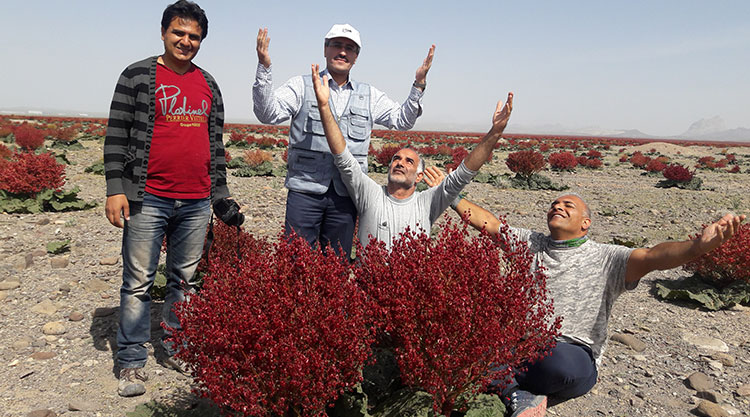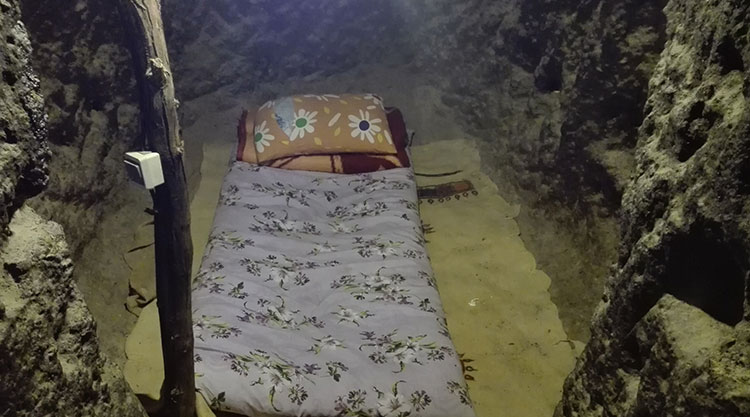Maymand is a self-contained, semi-arid area at the end of a valley at the southern extremity of Iran’s central mountains. The villagers are semi-nomadic agro-pastoralists. They raise their animals on mountain pastures, living in temporary settlements in spring and autumn. During the winter months they live lower down the valley in cave dwellings carved out of the soft rock, an unusual form of housing in a dry, desert environment.
This cultural landscape is an example of a system that appears to have been more widespread in the past and involves the movement of people rather than animals.
The winter troglodytic houses are carved out of the soft rock, in layers of up to five houses in height. Around 400 Kiches or houses have been identified and 123 units are intact. Each house has between one and seven rooms, traditionally used for living, and storage.
Prehistoric Troglodytic Village

Meymand (also spelt Maymand and Maimand) is a village of troglodytes – cave dwellers – located in the south-eastern Iranian province of Kerman. Meymand (Maymand, Maimand) village has been continuously inhabited for 2,000 to 3,000 years making it one of Iran’s four oldest surviving villages. By contrast the troglodytic village of Kandovan in northwest Iran is said to have been inhabited for 700 years. Some claim that Meymand / Maymand village has been inhabited for 12,000 years, that is, since the middle stone ages, making it a mesolithic village. Reportedly, 10,000 year old stone engravings and 6,000 year-old pottery have been discovered at the site.
The village is a UNESCO world heritage site and was awarded UNESCO’s 2005 Melina Mercouri prize.
While many Iranian desert villages are fairly non-descript in appearance most of the time (their beauty is found within the courtyards and homes), Maymand is in comparison stark in appearance and perhaps even unattractive in the usual sense. The villagers have done little to add colour to the natural earth tones of the landscape. Their homes and streets have no potted flowers or ornamental plants. The village’s stark appearance is complimented by Spartan life of its inhabitants. Adults wear sober coloured clothes and visitors have noted in their travel logs that they could hear no music.
The village has a present peak population of between 130 and 150 people many of whom are semi-nomadic shepherds, living in the village caves during the winter when the population is at its highest and migrating to higher pastures in the summer leaving about 60 residents in the village.
Links to Zoroastrian and Pre-Zoroastrian Customs

According to local tradition, Maymand was a Zoroastrian settlement before the advent of Islam and that prior to become Zoroastrian, the residents worshipped the sun.
One of the cave units which is now a museum has a sign post stating that it was an Atash-Kadeh, a fire temple, and there are claims that the ancient inhabitants also worshipped pre-Zoroastrian Mithraism.
Location
Maymand / Meymand village is located some 35 kilometres northeast of the town of Babak – Shahr-e Babak, a Kermani town on the road that runs between Tehran in the north and the port of Bandar Abbas in the south. Shahr-e Babak means Babak’s city and Shahr-e Babak is said to be the birthplace of the founder of the Persian Sassanian dynasty. The road from Shahr-e Babak rises into the surrounding mountains until it reaches Maymand at an elevation of 2240 metres.
We do not know if any of the cave units have been adapted from natural caves, for most of the cave dwelling units have been dug out by hand. The cave units line two sides of a shallow valley and in some areas, the cave apartments are five stories high.
The are a total of 406 residential cave units with a total of 2560 rooms. A large number of the units have been abandoned.
Construction of the Cave Dwellings
As we have noted above the cave dwelling units have been made by burrowing into the hillside’s soft sedimentary rock deposited in layers during the Mesozoic age some 100 to 200 million years ago. Sedimentary rock is a rock formed on the earth’s surface. It is formed by a sea or glacier carrying and depositing as sediment eroded rock from elsewhere as a strata. The sediment usually sits on top of harder rock formed within the earth and gradually hardens. The concrete-like consistency of the Meymand’s sedimentary rock is soft enough to be shaped by manual labour while still being hard enough to support the roofs of the cave units.

The individuals cave dwelling units are about 2 metres high and have an area of around 16-20 square metres. The construction of a cave dwelling called a kicheh starts with the chiselling of 6 to 9 meter horizontalcuts into the cliff-side. There are presently some 400 kichehs /dwellings in Meymand. The dwellings usually consist of a single square or round room. Windows where possible are hewed openings approximately 75 cm across. Otherwise, the dwellings are windowless and dark not just because of the lack of natural light but also because of the soot from fires and candles that coat the walls. Some dwellings have more than one room and even an attached stable or animal shelter.
Doors to the dwellings are commonly made of wood and fitted with a secured latch known as koleydun which locks onto a hole drilled into the stone frame. Not all the doors are rectangular. Some have the shape of standing human body, narrower at the base and widening at the top to shoulder width. To prevent water egress, the threshold of the doors are raised some 15 to 20 cm. above the level of the kicheh.
Since the lower slopes have a shallow gradient, the entrance to the units is often preceded by a trench whose walls rise until the hillside is tall enough to accommodate a dwelling unit. At times the lower cave dwellings are grouped like town houses so that the entrance trenches of up to five dwellings open onto a terrace known as a dalan. The dalans are used for family and social gatherings.






